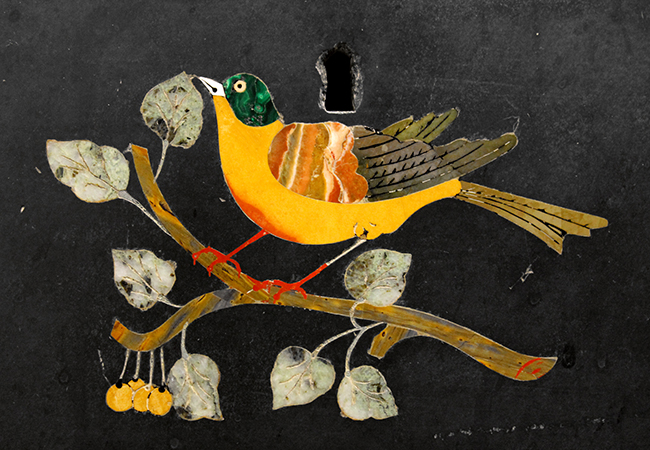
Introduction
The University holds a large artistic heritage that is allocated between Iglesia de la Anunciación, the University Chapel, the Rectorate and faculties of Geography and History, and Philology. Even though it is possible to visit collections, a good part of this heritage has been uploaded to an online database that is open to the public. This section has been dedicated especially to sculpture, painting and decorative arts. For information about other collections, please return to the home page.
Although much of the collection of altarpieces and sculptures of the University is located at Iglesia de la Anunciación, with the transfer of the University to the old Tobacco Factory, the works that decorate the Chapel in the Factory are inherited. From the first half of the sixteenth century, it is worth mentioning the Virgin of Bethlehem made by the circle of Torrigiano. From the beginning of the 17th century we can mention the reliquary bust of St. Francis Xavier attributed to Juan de Mesa. Presiding over the Chapel we find the Christ of the Good Death of Juan de Mesa, made in 1620.
The Rectorate and the faculties of Geography and History, and Philology also contain part of the artistic collections of the University.
It is worth highlighting the painting of Marinus Van Reymerswaele, St Geronimo, made in 1550 circa, and two oils on copper made by Francisco Pacheco in 1623 entitled The Annunciation.
At the Paraninfo there are valuable pictorial works of the sixteenth and seventeenth centuries, such as the Apparition of Christ to St. Ignatius of Loyola by Pablo Céspedes; The Ecstasy of St. Francis Xavier attributed to Francisco Herrera the Elder or the allegorical representation that shows Christ and the Virgin as protectors of child Esteban Márquez.
In addition, the pictorial collection of the University was enriched in 1911, when a small but important group of works (that have been conserved and exposed with all decorum and care) were received as deposit of Museo del Prado. One of them is the Portrait of a clergyman writer, work dated 1650 and attributed to Francisco Herrera the Elder.
Important, but of discrete artistic level is the collection of paintings of illustrious men linked to the University and rectors, which has been forming since the beginning of the nineteenth century.
Regarding decorative arts, a very small group, mostly from the 19th century, has come down to us, although parts of the 16th and 18th centuries are preserved. The set consists of some furniture pieces, silver objects and ceramic pieces. The most outstanding pieces of this collection are placed in the Rectorate. Of particular note amongst them are the silver ceremonial maces of the third quarter of the sixteenth century that are stylistically related to Hernando de Ballesteros the Younger, author of the blandones of the Seville Cathedral that he made between 1579 and 1580.
Also in silver and dated from late eighteenth or early nineteenth century it is worth to mention some vases, used as voting urns, made by Antonio Agustín Méndez and candlesticks, made by José Guzmán. Also noteworthy are two silver writing desks from the second half of the 19th century, made respectively in neoclassical and empire style and an ebony wood chair dated between 1759-1789.
History
Most part of the sculptural and pictorial heritage comes from the Jesuits. When they were expelled by Charles III in the eighteenth century, the University moved to the Professed House of this Order in Seville. Thus, by royal disposition, much of the artistic assets of the order passed to the University. The disentailment policies of Mendizábal in 1835 will also increase the university heritage.
The French occupation meant the loss of some works. This Jesuitical heritage is known thanks to a manuscript of Fr. Antonio de Solís S.J., relative to the history of the Professed House of Seville for two hundred and six years. It was written in 1755 and there is a copy in the Central Library of the University.
Although much of the collection of altarpieces and sculptures of the University is placed at Iglesia de la Anunciación, with the transfer of the University to the old Tobacco Factory, the works that decorate the Factory Chapel were inherited. Also, the Rectorate and the faculties of Geography and History, and Philology contain part of the artistic collections of the University.
Further Information
The collection is housed in different spaces of the University (Rectorate, Iglesia de la Anunciación and University Chapel) and cannot be visited in its entirety.
Location and opening hours
Rectorate: 08:00–21:00h. Calle San Fernando 4, 41004, Sevilla.
University Chapel: 12:30–14:30h. / 19:00–21:00h. Calle San Fernando 4, 41004, Sevilla.
Iglesia de la Anunciación: 11:00–13:00h / 19:00-21:00h. Calle Laraña s/n. 41003, Sevilla.
Website
Director
Luis Méndez
